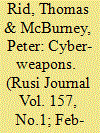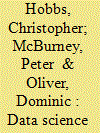| Srl | Item |
| 1 |
ID:
114385


|
|
|
|
|
| Publication |
2012.
|
| Summary/Abstract |
What are cyber-weapons? Instruments of code-borne attack span a wide spectrum, from generic but low-potential tools to specific but high-potential weaponry. This distinction brings into relief a two-pronged hypothesis that stands in stark contrast to some of the received wisdom on cyber-security. Maximising the destructive potential of a cyber-weapon is likely to come with a double effect: it will significantly increase the resources, intelligence and time required for development and deployment - and more destructive potential is likely to decrease the number of targets, the risk of collateral damage and the political utility of cyber-weapons.
|
|
|
|
|
|
|
|
|
|
|
|
|
|
|
|
| 2 |
ID:
177822


|
|
|
|
|
| Summary/Abstract |
Radiation detection technology is widely deployed to identify undeclared nuclear or radiological materials in transit. However, in certain environments the effective use of radiation detection systems is complicated by the presence of significant quantities of naturally occurring radioactive materials that trigger nuisance alarms which divert attention from valid investigations. The frequency of nuisance alarms sometimes results in the raising of alarming thresholds, reducing the likelihood that systems will detect the low levels of radioactivity produced by key threat materials such as shielded highly enriched uranium. This paper explores the potential of using data science techniques, such as dynamic time warping and agglomerative hierarchical clustering, to provide new insights into the cause of alarms within the maritime shipping environment. These methods are used to analyze the spatial radiation profiles generated by shipments of naturally occurring radioactive materials as they are passed through radiation portal monitors. Applied to a real-life dataset of alarming occupancies, the application of these techniques is shown to preferentially group and identify similar commodities. With further testing and development, the data-driven approach to alarm assessment presented in this paper could be used to characterize shipments of naturally occurring radioactive materials at the primary scanning stage, significantly reducing time spent resolving nuisance alarms.
|
|
|
|
|
|
|
|
|
|
|
|
|
|
|
|